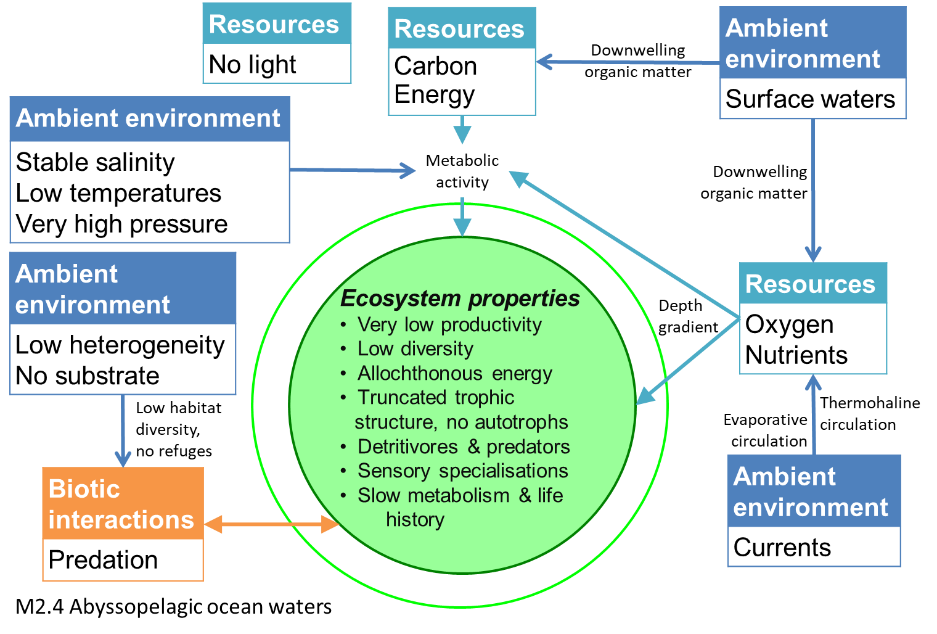Global ecosystem typology
Alternative site for the Global ecosystem typology with additional information for ecosystem profiles and indicative maps.
This site is maintained by jrfep
M2.4 Abyssopelagic ocean waters
Biome: M2. Pelagic ocean waters biome
Contributors:
(texts)
At greater depths (~3,000-6,000m) than bathypelagic systems, these very deep open ocean ecosystems receive no light and rely solely on debris from upper layers for nutrients. Other resources such as oxygen are replenished via the ‘global ocean conveyer belt’ (thermohaline circulation) that starts when distant, polar surface waters cool and sink. There is a low diversity and low density of life, largely planktonic detritivores, along with some gelatinous invertebrates and scavenging or predatory fish like the anglerfish. Life histories body structures and physiological traits are adapted to the very high pressure and lack of light (e.g. non-visual sensory organs, specialised metabolic proteins, and low density body structures).
Key Features
Lightless, high pressure depths with limited nutrients and low biodiversity of adapted detrivores, jellies, scavengers and predatory fish.
Overview of distribution
Deep oceans between 3000 - 6000m.
Profile versions
- v1.0 (2020-01-20): C Linardich; DA Keith
- v2.0 (2020-05-27): C Linardich; DA Keith
- v2.01 ():
- v2.1 (2022-04-06): C Linardich; DA Keith Full profile available at official site
Main references
Selected references for this functional group:
Priede, IG (2017) Deep-sea fishes: Biology, diversity, ecology and fisheries Chapter 1. Cambridge University Press, Cambridge DOI:10.1017/9781316018330
Diagrammatic assembly model

Maps
Maps are indicative of global distribution patterns are not intended to represent fine-scale patterns. The maps show areas of the world containing major (coloured red) or minor occurrences (coloured yellow) of each ecosystem functional group. See general notes on maps.
There are 2 alternative versions of the indicative map for this functional group, please compare description and sources below.
M2.4.IM.orig_v1.0
Datasets
- SRTM30-PLUS-V11
Map references
Becker JJ, Sandwell DT, Smith WHF, Braud J, Binder B, Depner J, Fabre D, Factor J, Ingalls S, Kim S-H, Ladner R, Marks K, Nelson S, Pharaoh A, Trimmer R, Von Rosenberg J, Wallace G, Weatherall P (2009) Global Bathymetry and Elevation Data at 30 Arc Seconds Resolution: SRTM30_PLUS, Marine Geodesy 32: 355-371. DOI:10.1080/01490410903297766
M2.4.web.orig_v1.0

Datasets
- SRTM30-PLUS-V11
Map references
Becker JJ, Sandwell DT, Smith WHF, Braud J, Binder B, Depner J, Fabre D, Factor J, Ingalls S, Kim S-H, Ladner R, Marks K, Nelson S, Pharaoh A, Trimmer R, Von Rosenberg J, Wallace G, Weatherall P (2009) Global Bathymetry and Elevation Data at 30 Arc Seconds Resolution: SRTM30_PLUS, Marine Geodesy 32: 355-371. DOI:10.1080/01490410903297766
Check: the Glossary / Profile structure / the public document